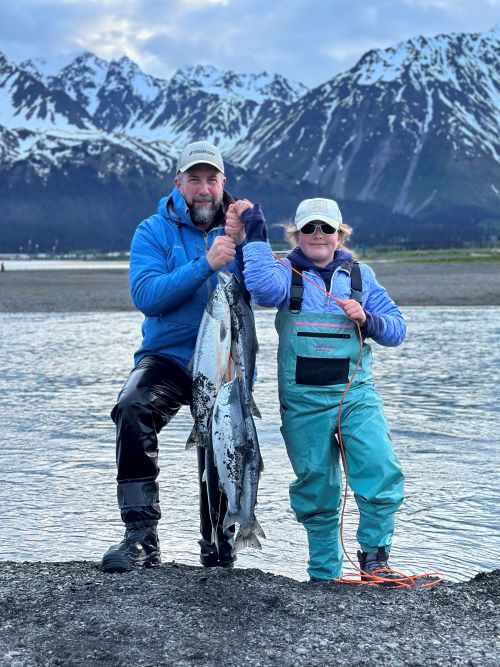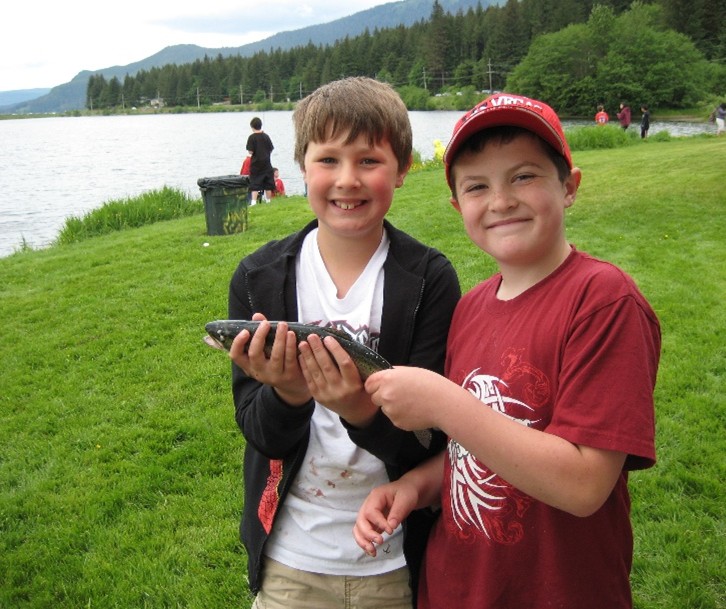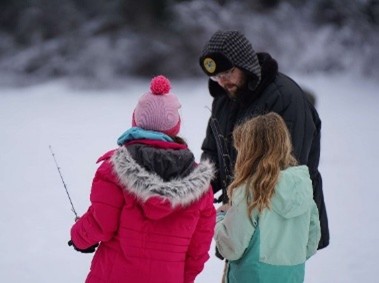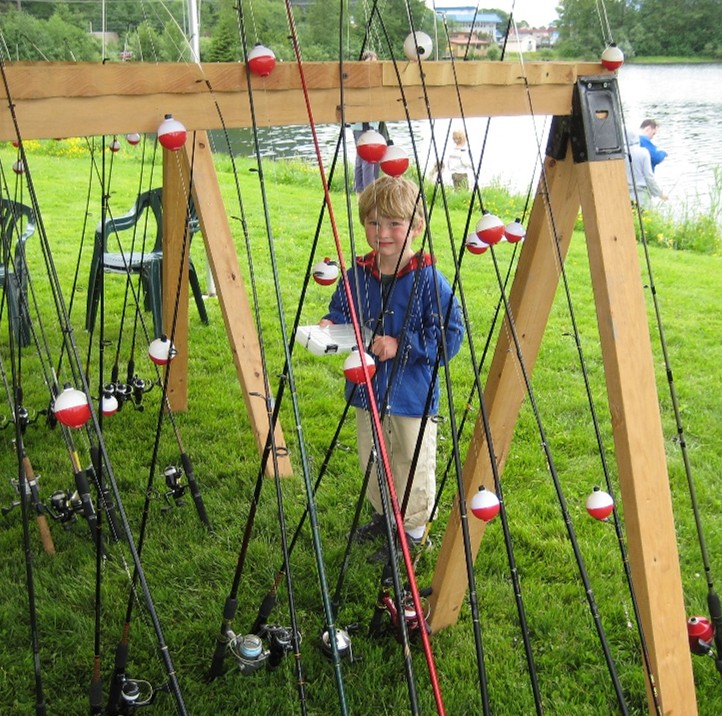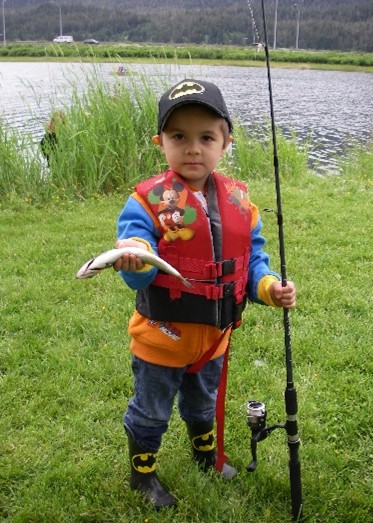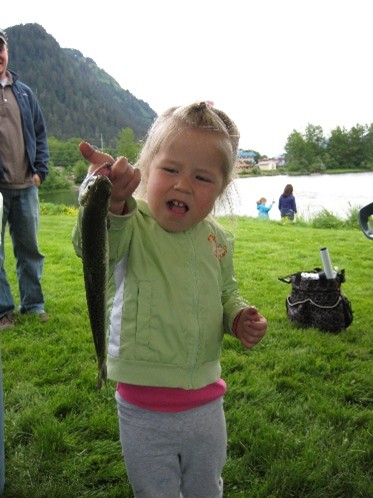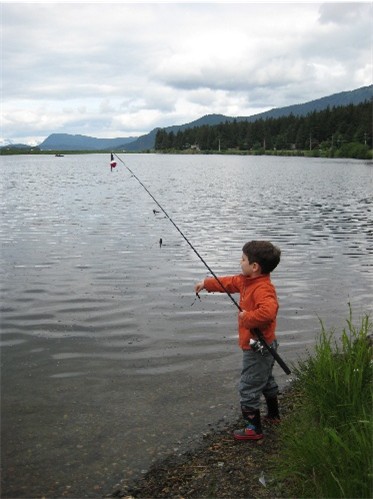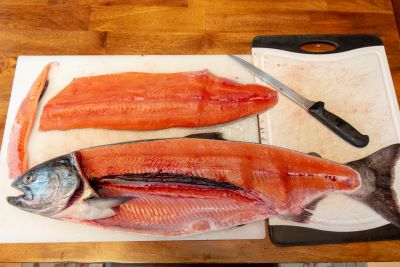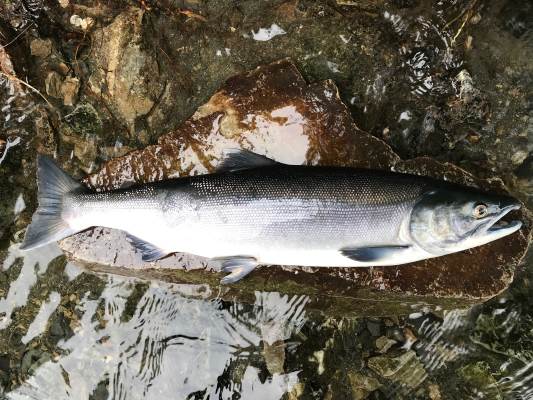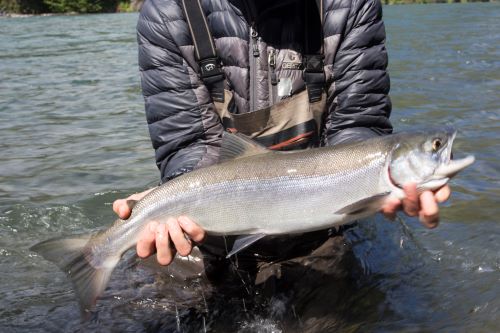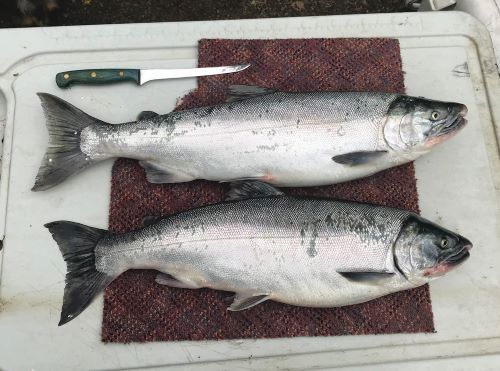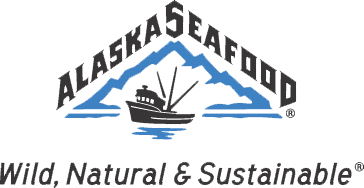
June 2025
Issue 90
Cast, Catch, Connect: Celebrate Alaska’s Family Fishing Traditions!
It’s June and the fishing season is in full swing.
June is the month when many anglers take to the water to begin the process of filling their freezers with fresh salmon fillets.
Visit our online store if you need to purchase your 2025 sport fishing license. Or download the ADF&G mobile app and you can store your licenses, tags and permits in your mobile device.
If you have a comment or story ideas for Reel Times, we encourage you to send them our way. You can send comments to ryan.ragan@alaska.gov.
Reel in the Fun – Family Fishing Days in Southeast Alaska
By Jess Etheridge (Juneau Assistant Area Management Biologist)
There’s nothing quite like the thrill of feeling that first tug on the line, especially when you're a kid! Across Southeast Alaska, families are trading screen time for rod time, and it’s all part of our annual Family Fishing Day celebrations. These events are designed with young anglers in mind and offer a wonderful opportunity for families to connect, not just with each other, but also with Alaska’s incredible fisheries and natural beauty.
Whether it’s reeling in a rainbow trout from a local pond or hooking a feisty salmon in saltwater, these free, family-friendly events are packed with fishing, games, prizes, and hands-on learning. You don’t even need to bring your own gear—rods, tackle, and all the essentials are often provided on-site for free, along with plenty of tips, encouragement, and new fish stories waiting to be made.
Family Fishing Days are more than just a fun outing, they’re a chance to introduce kids to the joys of fishing, teach important conservation values, and create memories that last a lifetime. Whether your child is an experienced angler or casting a line for the very first time, there’s something here for everyone to enjoy.
Even if you missed your local event this year, don’t worry! Family Fishing Days are traditions that return each year, bringing communities together to celebrate Alaska’s rich fishing heritage. So, gather your family, invite some friends, and dive into the fun happening all around the region.
Community Fishing Day Highlights
Haines - Winter (January)
Families in Haines and Klukwan bundle up for a winter adventure at Mosquito Lake each January. Hosted by the Alaska Department of Fish and Game (ADF&G), Takshanuk Watershed Council, Chilkoot Indian Association, and Alaska State Parks, kids learn to ice fish for rainbow trout, cutthroat, and Dolly Varden. Between jigging sessions, young anglers warm up by the fire, roast marshmallows, and learn about local watersheds. It’s a great way to enjoy the outdoors, even in winter!
Petersburg - Mid May
The Lil’ Fisk Derby, part of the Little Norway Festival, is a local favorite that draws more than 120 kids. ADF&G collaborates with the Sons of Norway and the Petersburg Chamber of Commerce to host this fun event. Young anglers compete for quirky and classic awards, from biggest fish to the most unusual fish. It’s all about fun, learning, and community.
Sitka - Early June
At the Swan Lake Junior Trout Derby, the excitement starts with a United States Coast Guard (USCG) helicopter delivery of wild rainbow trout from Sukoi Lake. This 83-year tradition draws 150–200 participants and features prizes, fishing from shore or boat, and one-day-only bait use. The event is organized by the United States Forest Service (USFS), ADF&G, and Rotary Club.
Ketchikan - Mid June
City Park Ponds comes alive with excitement as the USFS and ADF&G host a fun-filled day for young anglers. The ponds are stocked with rainbow trout (raised at Deer Mountain Hatchery operated by Southern Southeast Regional Aquaculture Association, SSRAA) just in time for the event, and kids can enjoy hands-on activities like casting games, fish printing, and lure-making. This welcoming event is perfect for first-time fishers and families alike.
Wrangell - Mid to Late June
Pat’s Lake hosts this fun event, brought to you by the USFS Wrangell District, WCA Earth Branch, ADF&G, and the Wrangell Boys and Girl Scouts. The day includes fishing, lunch, games, and crafts. Special weekend fishing regulations allow kids under 16 to use bait and keep up to two cutthroat trout with no size limit. Fishing gear and PFDs may be available onsite.
Juneau - Late June to Early July
Lena Cove hosts this family-friendly event, organized by ADF&G, USFS, and Trout Unlimited. Kids can borrow rods, learn to cast, identify fish, and enjoy fun activities like coloring and tide pooling. It’s a great way to get outdoors and discover fishing in Juneau.
Kake - Early August
The Kake Kids Fishing Derby is a community collaboration between USFS, the Organized Village of Kake (OVK), Kake Tribal Corporation, ADF&G, Northern Southeast Regional Aquaculture Association (NSRAA), and the Wrangell Boys and Girl Scouts. Local businesses and residents donate prizes like bikes, fishing rods, and gift cards. Kids enjoy fishing, crafting lures, nature-print shirts, insect ID, and a free barbecue lunch.
Prince of Wales - Early August
Hosted by USFS and ADF&G at Gravelly Creek Recreation Site on the Thorne River, this Kids Fishing Day features a derby for pink and coho salmon and Dolly Varden. Kids compete for prizes in various age groups, and fish can be measured and released. The event also offers fun booths with activities like fish printing, lure making, and casting games.
Mark Your Calendars!
Exact dates may shift slightly each year, so check local postings or reach out to your regional or local area ADF&G office for final event details. Whether it’s your child’s first catch or just a great day outdoors, Family Fishing Days are your chance to unplug, learn an outdoor skill, and create lifelong memories together.
Illegally Dumped Fish Waste Invites Bears, Fines
With Southcentral Alaska salmon fisheries well underway, anglers and dipnetters are reminded to dispose of fish waste properly. Discarding fish waste on public or private property or along roads, pull-offs, and trails can attract bears into residential areas and result in fines ranging from $300 to $1,000.
In Anchorage, home to nearly 300,000 people, fish waste is illegally discarded each year in vacant lots, greenbelts, and along city streams and lakeshores. Anchorage area wildlife biologist Cory Stantorf believes many people who dump fish waste don’t realize the danger they create for others.
“Improper disposal of fish carcasses can and will draw bears to neighborhoods," said Stantorf, “and brown bears, particularly, may aggressively defend those food sources."
The problem isn’t limited to Anchorage. Illegally discarded fish waste also sets the stage for human/bear conflicts in the Matanuska-Susitna Valley and on the Kenai Peninsula. Illegal dumping is prohibited under Alaska’s littering laws.
Anglers and dipnetters who clean fish on-site should chop carcasses into numerous pieces and throw them into fast-moving water. Those who remove fish from the fishing site and fillet or process them elsewhere should consider the following recommendations:
- If allowed, fish waste should be taken directly to a waste transfer station or to the landfill. Another option is to freeze fish waste to eliminate odors and then place it out with garbage on the morning of trash pickup. Do not place waste out the night before pickup.
- The Central Peninsula Landfill located at Mile 98.5 Sterling Highway 2.5 miles south of Soldotna accepts fish waste free of charge from 8 a.m. to 5:45 p.m. seven days a week in summer.
- Fish waste can also be deposited at Kenai Peninsula transfer facilities, including those in Cooper Landing, Kasilof, and Ninilchik, but in smaller quantities; all fish waste must be double-bagged in plastic trash bags with a limit of two bags dropped off per day.
- Anchorage Regional Landfill, the city’s Central Transfer Station, and the Girdwood Transfer Station all accept residential, non-commercial fish waste.
- Matanuska-Susitna Borough Solid Waste accepts small quantities of non-commercial fishwaste (less than 150 pounds) at the Central Landfill located at N. 49th State Street in Palmer.
Must be double-bagged and tied in leak-proof bags. For more information, call 907-861-7801.
Media Contact: For more information contact Anchorage area wildlife biologist Cory Stantorf at cory.stantorf@alaska.gov (907-267-2811), or sportfish biologist Donnie Arthur at Donald.arthur@alaska.gov (907-267-2225).
Sockeye fishing on the Kenai and Russian rivers
June marks the beginning of some of Southcentral Alaska’s most popular sport fisheries, which include Kenai and Russian river sockeye salmon. These fisheries attract thousands of anglers from around the state and from places abroad every year. On average, 350,000 sockeye salmon are harvested by sport anglers annually from the Kenai and Russian rivers.
There are numerous access sites anglers can utilize to take advantage of fishing for this plentiful resource. There are also numerous regulations pertaining to bag and possession limits, seasons, and tackle or bait limits anglers should be aware of before venturing out for a day of fishing. You’ll find regulations in the Southcentral Sport Fishing Regulations Summary booklet. ADF&G may release an Advisory Announcement and Emergency Orders to open, liberalize, close, or restrict fisheries during times of biological need. Anglers can find the Advisory Announcements and Emergency Orders through the ADF&G webpage. Anglers may also subscribe to receive email notifications of the Advisory Announcements and Emergency Orders.
The most productive fishing areas are pools immediately downstream of shallow riffles, and mainstem close to shore. Sockeye salmon tend to hold in these areas before migrating through the riffles. Since this species travels close to shore, most sockeye salmon fishing takes place from the bank. Inexperienced sockeye salmon anglers often wade or cast too far out, not realizing the fish are often swimming right behind them.
If you’re lucky enough to hook a fish, pull up on your rod to set the hook. To bring attention to other anglers fishing close by say “fish on” to avoid snagging your neighbors line as you fight the fish. In crowded conditions, land your fish quickly. Try not to allow your line to cross others’. Playing your fish across others’ lines is rude, and interrupts fishing for everyone.
A landing net is a very useful item for landing a sockeye on the Kenai and Russian rivers. Remember it is illegal to keep snagged fish, the only legally hooked fish is when the fish is hooked in the mouth.
When fishing on the Kenai or Russian rivers, please be respectful and follow any requirements landowners may have. From July 1 through August 15, pay particular attention to seasonally closed banks on the Kenai River. Most people understand healthy river systems are important for strong and healthy salmon populations. However, it is important to ensure that clean, healthy rivers don’t stop at the water’s edge.
In fact, protecting and managing healthy streambanks and adjacent riparian areas are critical components to the overall health of a river system. Vegetation along streambanks helps keep river water clean by filtering out sediment and pollutants from surface and storm runoff, reduces peak flows during rain and runoff events, slows flood waters, stabilizes streambanks from excessive erosion, and helps moderate stream temperatures. Vegetated streambanks also provide food and nutrients to fish and other aquatic organisms, as well as, provides critical habitat for rearing juvenile salmon and trout. Any alteration to the streambank area reduces its ability to carry out these important functions, this includes repeat trampling of the vegetation while trying to get to your favorite fishing spot.
Following the simple steps below can help maintain important habitat for salmon and trout.
- Use established trails to reach the river.
- Use established entry and exit points to get in and out of the river.
- Respect and abide by signs that close areas to fishing from the bank.
- Stand in the river to fish and don’t place your pack or other gear on the vegetation.
- Pack out what you pack in, including discarded fishing line and tackle.
- Use the restroom in the provided facilities.
A few of the more popular fishing locations in the Kenai and Soldotna area include Centennial Park, Soldotna Visitors Center, Soldotna Creek Park, Moose Range Meadows, Swiftwater Campground, Rotary Park, Donald E. Gillman River Center, The Russian River fishery is accessed through via the U.S. Forest Service Russian River campground and Russian River Ferry service.
Caring for your Catch - Basics steps to preserving salmon
Pre-Trip Preparation
In preparation for a fishing trip, knives, cutting boards, stringers, or coolers should be cleaned with a sanitizing agent and allowed to fully dry. Starting with clean equipment while processing your fish will help minimize bacteria growth which can accelerate decomposition and subsequently create a bad taste. Taking time to plan what equipment you will need to transport harvested fish helps eliminate unforeseen situations where people transport more fish than they were prepared for. For example, the number or size of coolers needed will be different depending if you are going King salmon fishing at Ship Creek versus dip netting for sockeye salmon on the Kenai River. Along with your coolers, don’t forget to bring plenty of ice or ice packs (enough to last your whole trip) especially if your outing involves remote travel to the Alaskan bush.
Landing the Fish
After landing your salmon on the bank, beach, or boat, it’s important to bleed the fish and keep it cool. A quick “bonk” on top of the fish’s head, just behind the eyes, should stun or kill the fish. Then with your finger or knife sever one or more of the gill arches, located behind the gill cover. Bleeding the fish in water will greatly improve the efficiency of bleeding your catch. This can be accomplished by placing the fish in a container with water or on a stringer. It takes just a few minutes for the fish to finish bleeding out, at which point measures should be taken to keep the fish cool for the remainder of the fishing trip or until you are ready to process the fish. Ideally you want to have the fish in a near freezing environment to obtain optimum quality. The easiest method is with a slush mixture of ice and water. Add just enough ice to the water so that the fish will be able to submerge. By cooling the fish quickly, bacteria growth will be slowed, giving enough time to prepare for processing the fish.
Processing your catch
The most common method for preserving fish is to fillet and freeze the flesh. Filleting is the process where the flesh from each side of the fish is cut or sliced away from the backbone, rendering two slabs of meat with the skin attached. Whichever method is used to cut the fish, you will want to rinse the slime and blood from the fish prior to filleting the fish. This will help keep the cutting area clean. Fish slime is a great protective layer for a living fish swimming through the water, but it can contribute to the “fishy” taste if it gets on your salmon fillets. Once both fillets have been cut, rinse them thoroughly to remove any residual slime or blood before packaging.
There are many methods for preserving salmon including freezing, smoking, canning, and drying. Each of these methods requires a specific process and will produce a unique product. For the basic method of freezing a fillet it is recommended to vacuum seal the fillet whole or in meal sized portions. This method of preserving salmon can allow the fish to be consumed for up to a year without losing much quality or flavor. If you do not own a vacuum sealer, the units can be rented, or there are many different fish and game processors who can process your catch for a fee. If vacuum sealing is not an option for an angler, the fillets can be wrapped tightly in plastic wrap followed by freezer paper or placed in a resealable plastic bag. Fish frozen using this method should be consumed sooner than fish that are vacuumed sealed. After vacuum sealing or wrapping the fish, place the fish immediately into a freezer. The colder the better for preserving quality over the following months.
The extra care taken during processing makes all the difference in the quality of the fillet when it is cooked for friends and family during the winter months. Keep in mind the basics: be prepared and keep your harvest clean and cold.
Cucumber (& Toast) Bites with Creamy Alaska Salmon Spread
Try this great recipe for Cucumber (& Toast) Bites with Creamy Alaska Salmon Spread from the Alaska Seafood Marketing Institute.
Enjoy!
If you have any questions about the Reel Times newsletter, please contact Ryan Ragan at ryan.ragan@alaska.gov

